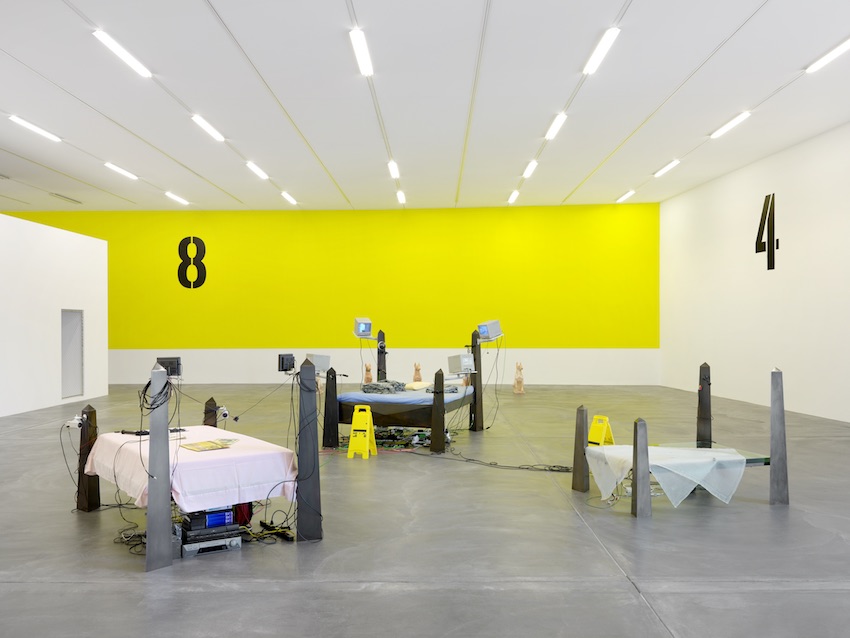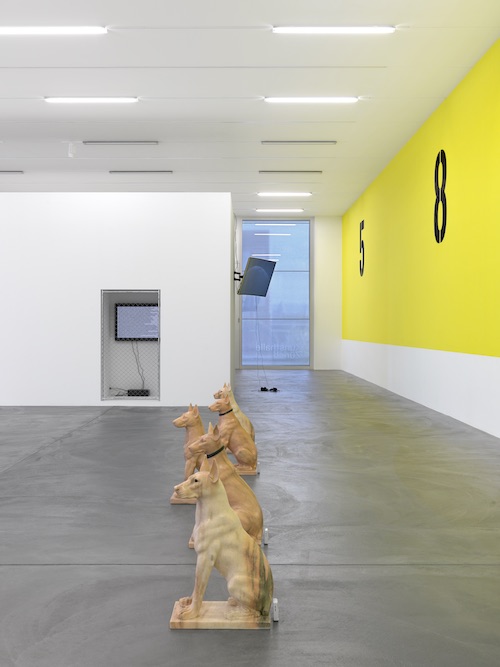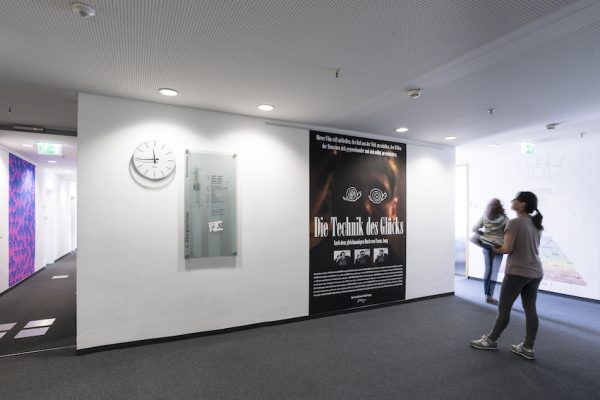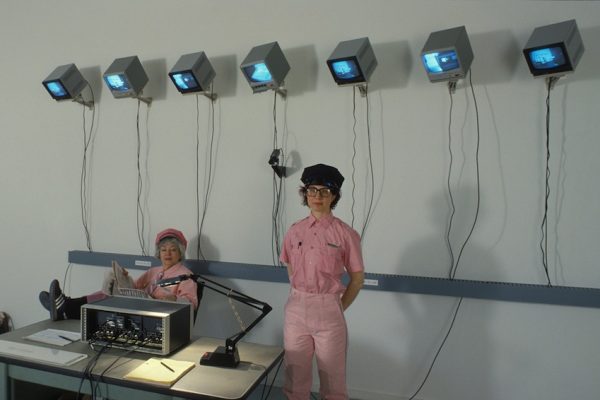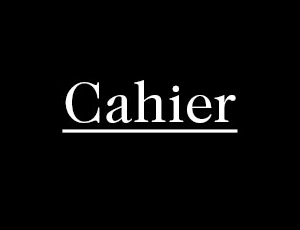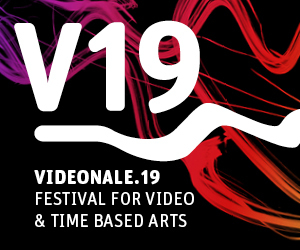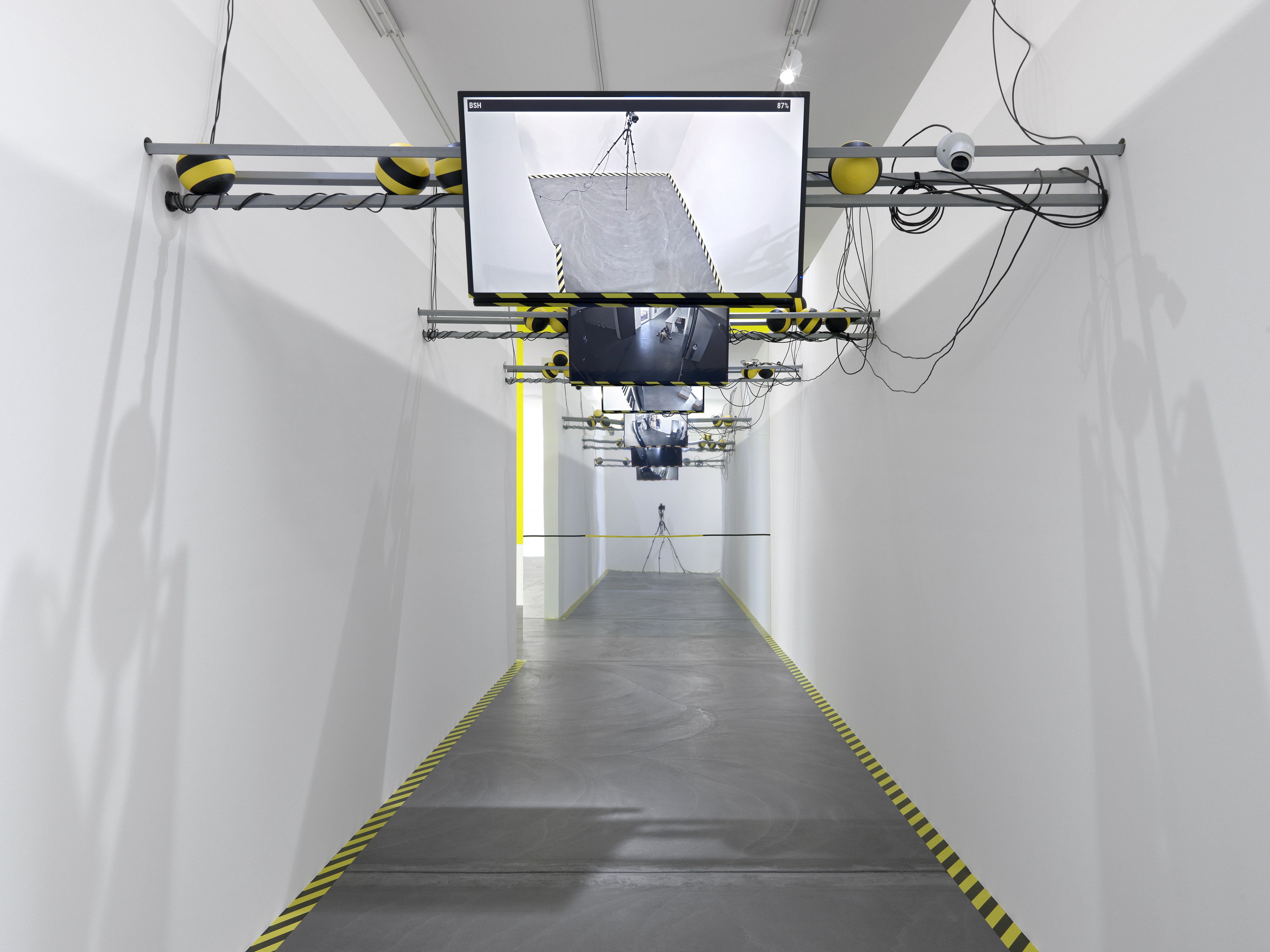
Julia Scher
Mark von Schlegell on Julia Scher „Maximum Security Society“ at Kunsthalle Zürich (8.10.22–15.1.23)
„Many kinds of surveillance once found only in high security military and prison settings are seeping into the society at large. Are we moving toward becoming a maximum security society where ever more of our behavior is known and subject to control?“ Gary T. Marx, „Surveillance and Society,“ Encyclopedia of Social Theory, 2005.
The timing of Maximum Security Society, Cologne-based artist Julia Scher’s large scale solo exhibition currently upstairs at the re-designed Zürich Kunsthalle, has been fortuitous. In an unplanned accident her show has served like a super-ego, worklike organizing presence to the uncontrolled desires set off but unfulfilled by the exhibition downstairs: DYOR. The acronym stands for „Do Your Own Research“ and since the phrase would make criticism obsolete it’s hard for me to describe it in more superficial terms than this: it is an attempt to present — „crypto“ „blockchain“ , „NFT“ , „VR“ etc. — as production in the context of contemporary art. Kenny Schachter’s amusing wall-sized screed NFTism, is the most recognizable art experience to be found in an exhibition that everywhere else looks and functions exactly like a tradeshow. Meanwhile systems of surveillance that depend on and exploit the hardware and energy that crypto and many NFT’s still depend upon, and with their hype, despite a rhetoric of decentralization, exponentially consume, are not discussed in this exhibition.
Happily, upstairs (in a brilliant touch of curatorial timing) Julia Scher’s humorous, and deeply resonant intervention in the imagination and experience of surveillance not only fills that gap, but shows itself, especially in this context, a champion of art as it has already been formulated.
First over the show’s threshold, we come upon Mama Bed, Baby Bed, and Papa Bed. These disarming 2003 complications take the Scher motif of surveillance bed, first appearing in Almost There (1996), into the childhood where technology of our own time has increasingly penetrated. Beds cornered with cameras and mounted closed circuit monitors, move seamlessly from the era of OnlyFans, through the closed circuit tech of Cloverfield (2008), through all the post-war decades and back to a Goldilocks zone deconstructing the idea of the nuclear family that might have been projected onto Scher’s own 1950’s Hollywood childhood. If these beds, quietly and insistently sculptural, implicate not only the home, but even ostensibly innocent analog, children’s books, in systems of surveillance, they remind us of how in the US the children’s book has often served also as a technological organ of control. A whip tossed casually on Mama Bed imagines power dynamics reorganized around a participatory system of female domination. Scher’s beds are filmed for the point of view of the observed, not the observing. Here it seems they serve the cameras, as they put themselves viewing on view, full of the yin/yang pleasures of the exibitionist/voyeur.
Meanwhile, the casual exposure of the labyrinthine webs of wiring and adapters necessary to keep 2003 U.S. technology alive in a Zürich gallery, reveals what DYOR removes from the visitor’s experience. Technology’s powers, the show powerfully illustrates, depend on the body of the architecture around us, and the blood of its electricity. The hunger for energy Scher’s cords knot and divide exposes the secret constancy of desire as it flows through the plastic and discarded rare metals with which we are everyday clotting up our world.
Art isn’t here to serve technology’s content. Here tech itself is content, and the surprise is how happy it seems to be transformed at last into something like a natural partner with art of the real human present. In today’s systematics of total corporate /capitalist surveillance it is exactly this widest, possible view — the view as it were, that belongs to art — that can be art’s gift to technology of the present.
At least one half of the present is female. Continuing projects begun decades ago, presenting new ones, initiating others, this exhibition considers how transformative a sustained, feminized experience of surveillance technology can be. Of course even in this situation the visitor’s long-surveilled brain naturally has them glancing up for the real, true surveillance they know continues anyway.
The funniest, simplest, and most intentionally female of the readymade combine works in this show, Architectural Vagina (1993/2022), reorients just that ur surveillance expectation to female sexuality, when we glance up and iIn place of the expected pointed phallus, Scher’s addition of palm leaves, locates the organ of observation to a more stimulating, clitoral position.
Scher has set up a zone of pleasure and literal exhibitionism for the bodies of surveillance she has assembled — ours among them. Everything in this collage of video, installation, sculpture, wall painting and actual security (visitors can destroy unwanted bacteria with Scher’s functioning Security by Julia 2020 disinfectant dispenser even before entering), shows the personal, human scaled touch of the artist, and her attention to our security — a term she has transformed over the years as much as surveillance.
In the interview accompanying the show, Scher locates this art’s origins in 1980s New York. She came late to the era of the Picture Generation, perfectly positioned to trace her special metier, surveillance, among the embarrassment of dross technology’s wave, increasingly cybernetic, was leaving behind. In this process Scher’s works began to function like non-violent stoppages of the larger systems attempting to absorb them.
American Fibroids 1996/2022 was originally intended as partly a reflection on and within the gentrification transforming, and virtually razing New York neighborhoods since the 1980s. Scher’s installed flee booth was a recreation of the 6th avenue flea market in Chelsea, the zone of inspiration and materiel for generations of New York artists, that was already being pushed out by the wave of the 1990s galleries (her own among them) gentrifying the neighborhood. In the piece, among gathered tables and objects from the past, Scher also presents stacks of her own exposed hard drives (already obsolete in 1993) as if for sale. The revealed hard discs, chromed and lined with the perfection of mint 1955 Cadillacs, are shockingly beautiful and jewel-like. They bear tags with data, but without price. Against this wider obsolescence, Scher’s flea market becomes a sort of a flea market in a flea market. This market steps beyond capitalism, becoming a place for another kind of exchange apart from the literal world, perfectly visible in its mirrored surfaces, and perfectly off limits. The piece’s metaphorology spills generally over the entire exhibition, presenting new combinations of flea-market turned museum, as opposed to the museum turned trade-show approach downstairs.
The fibroids spill literally into the adjoining installation — Predictive Engineering 1993/2022 — with yellow/black rubber balls („spheres“ the artist calls them) in the scaffolding, chiming with the security tape lining the interactive passageway. Here we walk through and under a series of suspended closed circuit monitors, showing security views of various areas of the museum we don’t expect to see in the here and now: the underground parking lot, the loading dock, the elevators, a stairwell … But whoever stops to watch, will find their expectations uncannily interrupted. For one thing, same sex strangers appear to be copulating in a car in the parking garage…
The scripted interference in the simulated technological context of control offers the sweetl security of fiction. Here one still chooses whether or not to be as secure a subject now as the surveilling eye. Meanwhile the tape that flickers yellow/black (working on the electricity of light itself) reminds us that outside the zone of art — this safety and freedom from systems of surveillance — is but a momentary passage. It will not constitute politics outside of this secure space.
Inside the show, outside and around Predictive Engineering, large scale wall paintings affirm it is very much with the possibilities of art that Scher walls out the dynamics of Capitalist Realist control. The broad, primary yellow of the enormous sign-painted gate numbers of Planet Greyhound 2022 wrap the entire gallery. It was hard not to think of Lawernce Weiner’s recent passing. Weiner’s print sculptures, videos and book surely help shore up the foundations of this confident show. Dan Graham, Scher’s friend and collaborator since the 1980s, also recently passed almost seems to walk through the exhibition like a ghost, glimpsable in various mirrors, video pieces, and the embraced US banal (as proclaimed by the Reagan era colors flooring American Fibroids). Graham joins a host of other artists and contemporaries, in a show aware of and proclaiming solidarity with art by the likes of Nam June Paik, Joan Jonas, Jenny Holzer, Valie Export, Andrea Fraser, Bruce Nauman and Dara Birnbaum.
We have to walk around the back of the installation to encounter the show’s most up-to-date technological intervention. Against the wall-painted yellow (color of alarm estheticsizing erotically against the blues and greys of the video) Scher presents the deep-fake, animated film at the heart of Planet Greyhound. Far less of a spectacle here than in its first presentation in Gießen, the film feels like the real production it mimes, and shows its strength in the context of the NFT show downstairs. Presenting itself as a seamlessly designed, but amusingly-low budget info-screen for a global and interplanetary bus station, opens up a fifth dimension of science fiction to expose the unconscious cosmic desires of the US transportation systems. Like the dog- icon of the bus, the video travels perfectly, always demarking a network involving this gallery, Rome and other planets.
Science fiction grand master Arthur C. Clarke famously said magic and any sufficiently advanced technology are indistinguishable. The marble stone dobermans with which Scher guards her own show know that magic — usually reported as some form of female subversion — existed long before the Pharoah’s architects began engineering the pyramids. Emitting her own tech-friendly voice from pocket recorders playing behind each dog, Scher places this magic new voicing, at the extreme tail end of the far older, stronger magic, fully embodied in long-standing animal representations.
If technology seeks to become art, it must be unashamed, and respectfully aware of its own body, and our own mind which it purports to serve. Art is ready to receive technology as medium, if tech can transform bodily into something like a natural partner — full of all that might mean. In a secular context the very word art depends on an understanding of work that seeks a body „out of its time.“ This foe of acceleration must immediately transform the current body offered, not simply conform to previously programmed conditions. Otherwise it will be swept away into time, and find itself almost immediately dated, as these obvious relevant works do not.
In the meantime, with part two of this exhibition coming in March 2023 to Mönchengladbach, those seeking security from surveillance in the Rhineland can be confident that, for now, the visualization of the organ of observation can proceed.
All images: Julia Scher, „Maximum Security Society“ Kunsthalle Zürich, 2022, installation view, image: Annik Wetter

